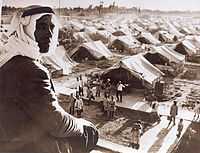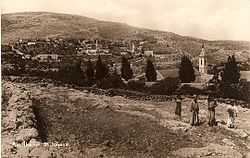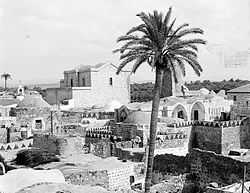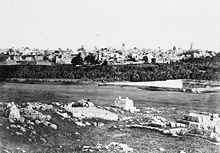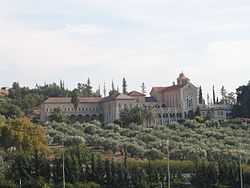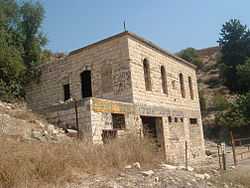List of Arab towns and villages depopulated during the 1948 Palestinian exodus
|
Around 400 Arab towns and villages were depopulated during the 1948 Palestinian exodus. Some places were entirely destroyed and left uninhabitable;[1][2] others were left with a few hundred residents and were repopulated by Jewish immigrants, then renamed.
Those areas that became a part of Israel and had at least a partial Arab population amounted to around 100 villages and two towns, while Arabs remained in small parts in some of the cities (Haifa, Jaffa and Acre) and Jerusalem was divided between Jordan and Israel. Around 30,000 Palestinians remained in Jerusalem in what became the Arab part of it, in addition to some of the 30,000 non-Jewish refugees moving to it, while there were 5,000 Jewish refugees from the Old City in the Israeli side. An overwhelming part of the Palestinian residents, and other non-Jews such as Greeks and Armenians, of the cities that became a part of Israel (Acre, Haifa, Safad, Tiberias, al-Majdal Asqalan, Beersheba, Jaffa and Beisan) fled or were expelled. Most of the Palestinians who remain there are internally displaced people from the villages around.[3]
There are more than 120 "village memorial books" about the history of the depopulated Palestinian villages. They are based on accounts given by villagers. Rochelle A. Davis have described the authors as seeking "to pass on information about their villages and their values to coming generations".[4]
The towns and villages are arranged according to the subdistricts of Mandatory Palestine they were situated in.
Acre Subdistrict
|
|
Beersheba Subdistrict
- al-Imara
- al-Jammama
- al-Khalasa
- Beersheba, military assault, expulsions, 20 October 1948
- Umm al-Rashrash
Beisan Subdistrict
|
-

The well at al-Khalasa, 1900–26
-
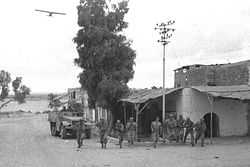
Israeli troops in Beersheba, 20 October 1948
Gaza Subdistrict
-

Al-Faluja, 28 February 1949
Haifa Subdistrict
Hebron Subdistrict
|
-

Bayt Jibrin, 2005
Jaffa Subdistrict
-

Yazur, 2008
Jenin Subdistrict
-
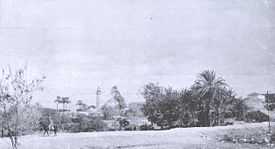
Zir'in, 1918
Jerusalem Subdistrict
-
.jpg)
Deir Yassin, now part of the Kfar Shaul Mental Health Center
Nazareth Subdistrict
- al-Mujaydil
- al-Subeih
- Indur
- Ma'alul
- Saffuriyya
Ramle Subdistrict
Safad Subdistrict
-

Safad, 1908
Tiberias Subdistrict
Tulkarm Subdistrict
-

Qaqun, 2008
See also
- Causes of the 1948 Palestinian exodus
- Transfer Committee
- Plan Dalet
- Khirba
- Palestine refugee camps
- 1948 Palestinian exodus from Lydda and Ramle
- List of villages depopulated during the Arab–Israeli conflict
- Jewish exodus from Arab and Muslim countries
- Syrian towns and villages depopulated in the Arab–Israeli conflict
- Killings and massacres during the 1948 Palestine war
- List of battles and operations in the 1948 Palestine war
Notes
- ↑ Benny Morris (2004). The Birth of the Palestinian Refugee Problem Revisited. Cambridge University Press. p. 342. ISBN 978-0-521-00967-6. Retrieved 22 May 2013.
About 400 villages and towns were depopulated in the course of the war and its immediate aftermath. By mid-1949, the majority of these sites were either completely or partly in ruins and uninhabitable.
- ↑ Naseer Aruri (20 July 2001). Palestinian Refugees: The Right of Return. Pluto Press. p. 50. ISBN 978-0-7453-1777-9. Retrieved 22 May 2013.
Of the 418 depopulated villages, 293 (70%) were totally destroyed and 90 (22%) were largely destroyed. Seven survived, including 'Ayn Karim (west of Jerusalem), but were taken by Israeli settlers.
- ↑ Davis, 2011, p. 238
- ↑ Davis, 2011, p. Preface - xvii
- ↑ 5.0 5.1 5.2 5.3 5.4 5.5 5.6 5.7 5.8 5.9 5.10 5.11 5.12 5.13 5.14 5.15 5.16 5.17 5.18 Morris 2004, p. xv
- ↑ Morris 2004, p. 423, p. 514, p. 536
- ↑ Morris, 2004, p.177.
- ↑ 8.0 8.1 Shavit 2004.
- ↑ Morris 2004, p. 500.
References
- Morris, Benny. The Birth of the Palestinian Refugee Problem Revisited. Cambridge University Press, 2004. See in particular pp. xiv–xviii, where Morris lists 389 Palestinian villages depopulated by massacres, expulsions, military assault, or flight.
- Morris, Benny. 1948: The First Arab–Israeli War. Yale University Press, 2008.
- Khalidi, Walid. (ed.) All That Remains: The Palestinian Villages Occupied and Depopulated by Israel in 1948. Institute for Palestine Studies 1992, 2006.
- Shavit, Ari. Deir Yasian: Survival of the Fittest, interview with Benny Morris, Haaretz, January 9, 2004.
- Davis, Rochelle A. (2011). Palestinian Village Histories: Geographies of the Displaced. Stanford University Press, Stanford, California. ISBN 978-0-8047-7312-6.
External links
| ||||||||||||||||||||||||||||||||||||||||||||||||||||||||||||||||||||||||||||||||||||||||||||||||||||||||||
| ||||||||||||||||||||||||||||||||||||||||||||||||||||||||||||||||||||||||||||||||||||||||||||||||||||||||||||||||||||||||||||||||||
